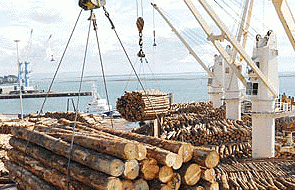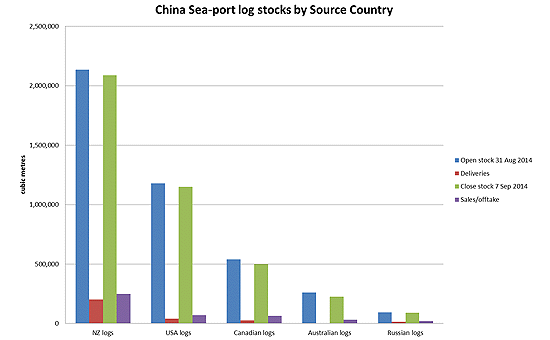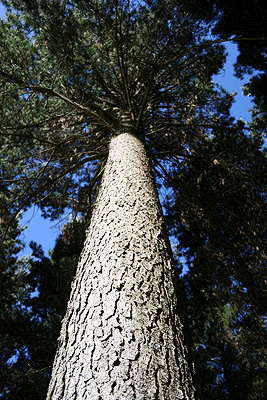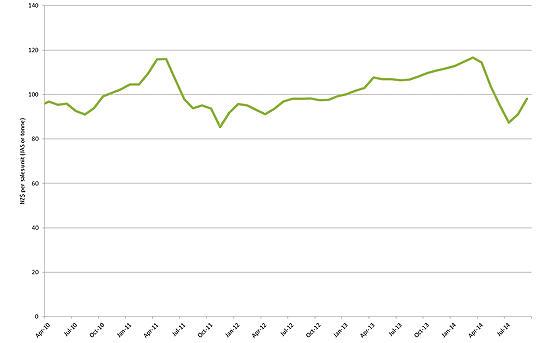

September saw another export log price increase, building on what is becoming a strong rebound from the dramatic slide in prices during the April to July 2014 period.
At-wharf-gate prices rose $10-15/JAS m3 in September.
This has been driven mainly by an increase in the CFR price (price paid by purchasers at China ports) and a lower kiwi dollar.
Ocean freight rates have firmed slightly since last month, partially offsetting the favourable changes in exchange rate and CFR price.
Strong demand for domestic logs continued, with tight supply of pulp, structural and pruned logs in several regions.
Export Log Market
Stubbornly high log inventories in China have dominated market commentary, along with caution as to the strength and duration of the nascent recovery.
The first week in September, however, if a harbinger of the market for the next few months, provides considerable comfort.

During this short (week long) period, log stocks plummeted 155,000 m3.
This was a result of deliveries (shipments unloaded) being only 42,000 m3 per day and strong sales (off take to market). Sales were 62,000 m3 per day, 5% higher than the daily rate for August.
Finally we are seeing a definitive supply response after four months of savage price falls; deliveries well below sales for all log sources. While total inventory is still high, if this snapshot continues, inventory should reduce quickly and put the market on a much stronger footing.
This observation must be tempered with reports of a continued slow-down of the housing market in China.
Year-to-date real estate sales for 2014 are tracking nearly 8% lower than in 2013. In addition, vacancy rates in some second and third-tier cities are very high. But it should be remembered that putting a dampener on the housing market has been a deliberate objective of the Chinese government, so its success should not be treated too harshly.
Clearly there are risks related to deflating asset values and excessive leverage, but as mentioned in last month’s Log Market report, the underpinnings of a continuation of significant investment in new housing in China seem robust.
India is NZ’s third largest log export market, but at around 1.4 million m3 per annum, it is well behind China at around 12 million m3. Korea comes in between at around 2.3 million m3. However, the potential of the Indian market is huge and New Zealand is well-positioned to capitalise on it.
Some of this potential relates to:
- India hosts the second largest population in the world at 1.21 billion.
- The average age is only 27 years old and 50% of the population is under 25. This demographic has the potential to be a strong driver of economic growth.
- India has a culture of wood use and uses wood extensively. Use has traditionally been mostly hardwoods which are becoming much harder and more expensive to source. Softwoods are gaining acceptance as a substitute.
- High domestic wood consumption and good availability of domestically-sourced wood in the past resulted in the development of thousands of domestic sawmills. Consequently, today, more than 90% of the imported wood is round-wood (logs) to keep the mills going.
- India has a large, and growing, wood supply deficit which will initially be satisfied by greater importation of softwood logs.
- Port and inland transport infrastructure currently constrain log imports. As this improves, greater volumes will be imported.
India has an innovative “slums to housing” programme.
Slum inhabitants who have lived in the same spot since 2000 hold rights to the land, but can sign these over to developers. If a developer can get over 70% of slum dwellers with property rights to consent to the development, the development can go ahead.
Part of the development comprises apartments which are given to the former slum inhabitants (in exchange for the contribution of the land and consent to develop). They own them, but can’t sell them for 10 years. The balance of the development comprises luxury apartments which the developer sells. One developer, Omkar, has successfully completed 12 projects, rehousing 40,000, with 12 more in the pipeline. All of this happens without the government contributing a single rupee.
Domestic Log Market
 Pruned logs are in strong demand both domestically and for export and have underpinned returns for some forest owners during the market down-turn. Pruned logs are in strong demand both domestically and for export and have underpinned returns for some forest owners during the market down-turn. |
As forest owners have been trying to avoid the worst of the severe down-turn in the export market, national harvesting levels has declined more this winter than usual. This has also constrained supply of some sought after domestic grades that are produced along with export grades. Pruned log production is struggling to keep up with strong demand. The shortage of pruned logs has been exacerbated by the export log recovery being strongest in pruned logs. As a result, prices are firm.
Again, this month, structural logs are well sought after and in short supply in some regions.
Strong demand for sawn timber in New Zealand continues of the back of strong building activity in Auckland and Canterbury. Export of sawn timber, on the other hand is down. According to Friday Offcuts, estimated domestic sawn timber use rose by 30% year-on-year for the second quarter, which was offset by a 26% decline in exports, and a 5% rise in stocks.
The largest declines in lumber exports were a 43% drop in exports to China, while exports to South East Asia, Australia and the US were down 10%, 11% and 6% respectively.
The outlook, however, is positive. New dwelling consents are now also increasing in regions outside of Auckland and Canterbury and both the latter regions are still to reach their forecast peak construction levels. In addition, a relatively strong Australian property market, and strongly growing USA property market should see steady demand from these higher-value markets. The falling NZ$ will also boost at-mill-door returns.
An increase in USA building activity has seen an increase in mouldings prices and increasingly NZ kiln-dried Radiata pine is going into clear boards. This market segment is less vulnerable to substitution by MDF and finger-jointed products which are taking market share from solid wood mouldings. USA housing starts are expected to surpass 1 million in 2014 followed by an additional 125,000 starts in 2015.
Since September is the last month of the third quarter and most domestic supply arrangements are negotiated quarterly, parties are currently commencing negotiations for fourth quarter sales.
The PF Olsen log price index increased again this month. It rose 7 points from 91 in August to 98 in September. It is still 19 points below the March 2014 peak of 117.
PF Olsen Log Price Index

Basis of Index: This Index is based on prices in the table below weighted in proportions that represent a broad average of log grades produced from a typical pruned forest with an approximate mix of 40% domestic and 60% export supply.
Indicative Average Current Log Prices
| Log Grade | $/tonne at mill | $/JAS m3 at wharf |
| Pruned (P40) | 144 | 139 |
| Structural (S30) | 101 | |
| Structural (S20) | 93 | |
| Export A | 99 | |
| Export K | 93 | |
| Export KI | 86 | |
| Pulp | 50 |
Note: Actual prices will vary according to regional supply/demand balances, varying cost structures and grade variation. These prices should be used as a guide only and specific advice sought for individual forests.
---------------------------------------------------------------
This article is reproduced from PF Olsen's Wood Matters, with permission.
We welcome your comments below. If you are not already registered, please register to comment
Remember we welcome robust, respectful and insightful debate. We don't welcome abusive or defamatory comments and will de-register those repeatedly making such comments. Our current comment policy is here.